From the Trenches
Fit for a Prince
By MARCO MEROLA
Monday, December 10, 2018
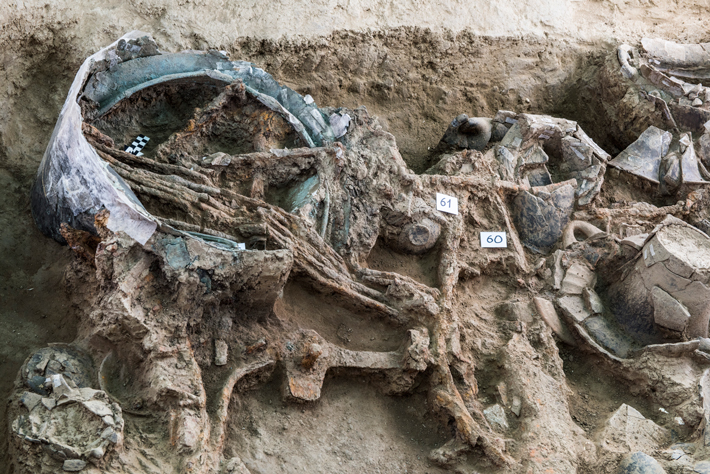 Between the ninth and the third centuries B.C., a people known as the Picenes moved from Latium in central Italy to the area covering today’s Marche and northern Abruzzo regions. Much of what is known about the Picenes, one of pre-Roman Italy’s most important cultures, comes from a number of burials discovered over the last few decades. Recently, archaeologists from the University of Bologna unearthed a large Picene tomb dating to the seventh century B.C. in the village of Corinaldo, near the Adriatic Coast.
Between the ninth and the third centuries B.C., a people known as the Picenes moved from Latium in central Italy to the area covering today’s Marche and northern Abruzzo regions. Much of what is known about the Picenes, one of pre-Roman Italy’s most important cultures, comes from a number of burials discovered over the last few decades. Recently, archaeologists from the University of Bologna unearthed a large Picene tomb dating to the seventh century B.C. in the village of Corinaldo, near the Adriatic Coast.
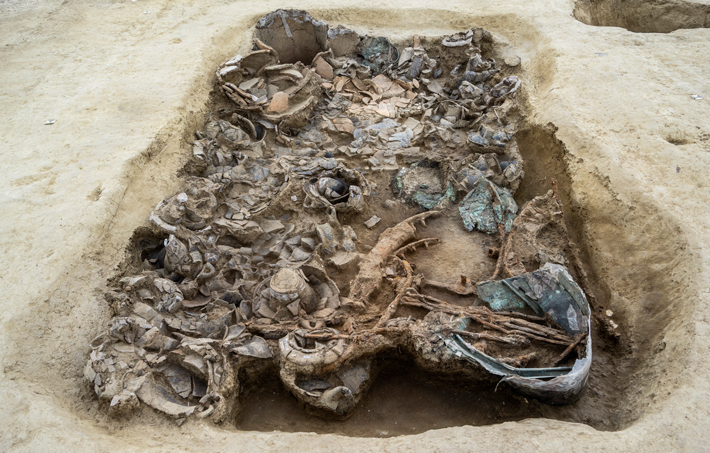 The burial, which team leader Federica Boschi has dubbed the “Tomb of the Picenian Prince,” was originally covered by a mound. It is nearly 130 feet square and was surrounded by a moat. Before this discovery, says Boschi, “no other Picenian tombs had been discovered in this region, which was a strategic location for cultural exchange between different pre-Roman populations,” as evidenced by vessels found in the burial that had been imported from Etruria, home of the Etruscans. The grave’s other contents, including a bronze helmet and weapons, bronze vessels, and a war chariot with iron wheels are, says Boschi, further evidence of the deceased’s aristocratic status.
The burial, which team leader Federica Boschi has dubbed the “Tomb of the Picenian Prince,” was originally covered by a mound. It is nearly 130 feet square and was surrounded by a moat. Before this discovery, says Boschi, “no other Picenian tombs had been discovered in this region, which was a strategic location for cultural exchange between different pre-Roman populations,” as evidenced by vessels found in the burial that had been imported from Etruria, home of the Etruscans. The grave’s other contents, including a bronze helmet and weapons, bronze vessels, and a war chariot with iron wheels are, says Boschi, further evidence of the deceased’s aristocratic status.
Ancient Amazonian Chocolatiers
By ZACH ZORICH
Monday, December 10, 2018
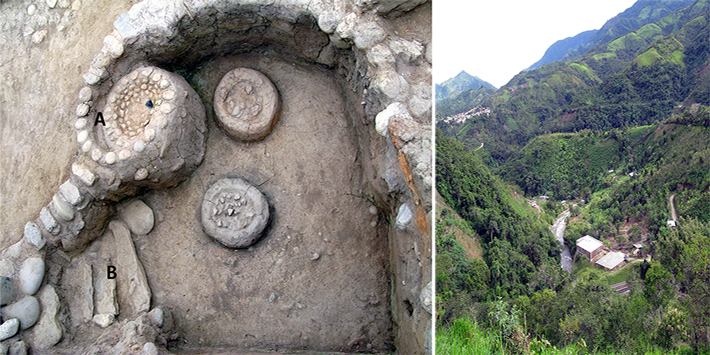 Cacao seeds, the raw material used to make chocolate, were being consumed in southeastern Ecuador much earlier than archaeologists have thought. The evidence comes from chemical analysis of bottles found at an ancient village now called Santa Ana-La Florida. "We were surprised at how clear the evidence of cacao use is 5,300 years ago and that it continues throughout the 3,000-year history of the site," says archaeologist Michael Blake of the University of British Columbia.
Cacao seeds, the raw material used to make chocolate, were being consumed in southeastern Ecuador much earlier than archaeologists have thought. The evidence comes from chemical analysis of bottles found at an ancient village now called Santa Ana-La Florida. "We were surprised at how clear the evidence of cacao use is 5,300 years ago and that it continues throughout the 3,000-year history of the site," says archaeologist Michael Blake of the University of British Columbia.
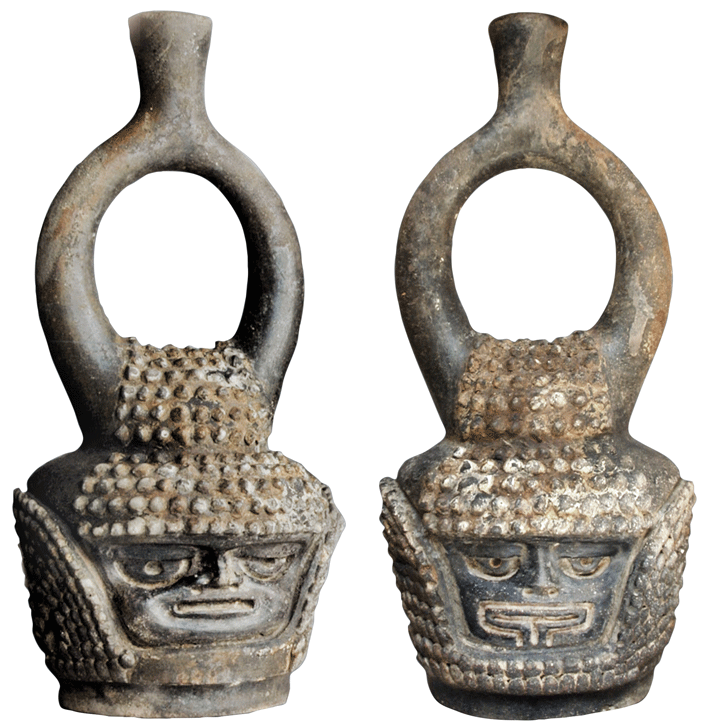 Ancient Ecuadorean cacao was, in all likelihood, not made into candy bars or anything else resembling modern chocolate. The people fermented the seeds and then dried and ground them to make a beverage. Modern indigenous people in Ecuador use cacao as a medicine and a stimulant, as well as an ingredient in food and drink. Domesticated cacao, researchers suggest, was traded from South American to Meso-american cultures, such as the Maya and Aztecs, starting at least 3,900 years ago.
Ancient Ecuadorean cacao was, in all likelihood, not made into candy bars or anything else resembling modern chocolate. The people fermented the seeds and then dried and ground them to make a beverage. Modern indigenous people in Ecuador use cacao as a medicine and a stimulant, as well as an ingredient in food and drink. Domesticated cacao, researchers suggest, was traded from South American to Meso-american cultures, such as the Maya and Aztecs, starting at least 3,900 years ago.
The Case of the Stolen Sumerian Antiquities
By DANIEL WEISS
Monday, December 10, 2018
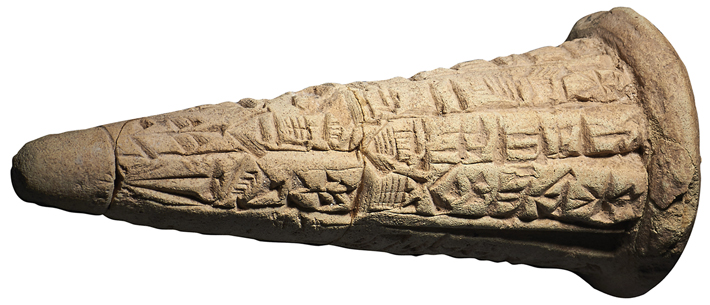 On May 2, 2003, shortly after the invasion of Iraq, London’s Metropolitan Police raided an antiquities dealer and seized eight artifacts they believed had been obtained through illicit channels. It’s typically impossible to trace looted antiquities back to their original context. But in this instance, through a combination of good fortune and canny sleuthing, experts were able to close the case.
On May 2, 2003, shortly after the invasion of Iraq, London’s Metropolitan Police raided an antiquities dealer and seized eight artifacts they believed had been obtained through illicit channels. It’s typically impossible to trace looted antiquities back to their original context. But in this instance, through a combination of good fortune and canny sleuthing, experts were able to close the case.
The artifacts—three ceramic cones bearing cuneiform inscriptions, one marble and one chalcedony stamp seal, a gypsum mace-head, a marble amulet pendant, and an inscribed river pebble—remained in police possession until late 2017, when they were brought to the British Museum and examined by St. John Simpson, a curator in the Middle East department. They appeared to him to have come from ancient Mesopotamia, and to have been produced by various cultures between the fourth and first millennia B.C. “It was clear they were from a big, important, multi-period site,” Simpson says. “That meant we had a short list of a very small number of places in southern Iraq.”
By an extraordinary stroke of luck, the previous year the museum had launched an excavation at just such a site: the ancient Sumerian city of Girsu, in modern-day Tello, in southern Iraq. Girsu was first excavated in the late nineteenth century and is among the world’s oldest known urban centers. Many inscribed artifacts from the site bear evidence of the birth of writing. Among the most important discoveries of the new excavation there, led by archaeologist Sebastien Rey, was of a temple called Eninnu, which was built around 2100 B.C. by Gudea, king of Lagash, the city-state of which Girsu was the capital. The temple was dedicated to Ningirsu, the Sumerian god of agriculture, thunder, and storms.
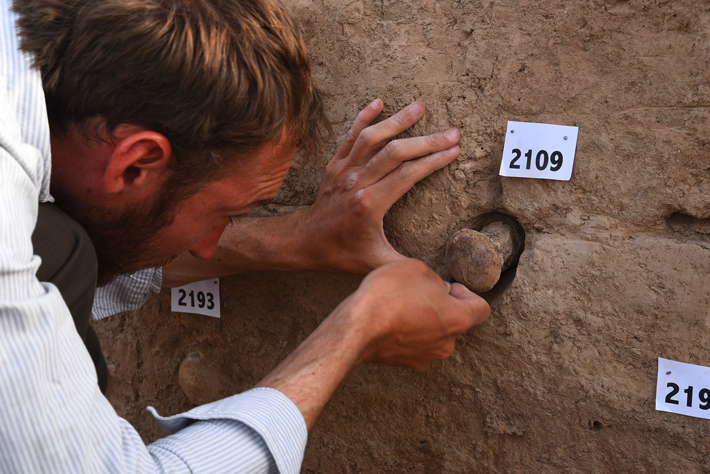 Soon after the artifacts arrived at the museum, Rey returned to London from Iraq. Simpson could hardly wait to show him the collection. “When I opened the box, I was shocked,” Rey recalls. “The first object I saw was an inscribed terracotta cone. It was identical to cones I had been retrieving in Tello a few weeks earlier.” All of the cones he had excavated bore an inscription that reads: “For Ningirsu, Enlil’s mighty warrior, Gudea, ruler of Lagash, made things function as they should (and) he built and restored for him his Eninnu, the White Thunderbird.” Says Rey, “One purpose of these objects was to say for eternity that this king had built a temple for his god.”
Soon after the artifacts arrived at the museum, Rey returned to London from Iraq. Simpson could hardly wait to show him the collection. “When I opened the box, I was shocked,” Rey recalls. “The first object I saw was an inscribed terracotta cone. It was identical to cones I had been retrieving in Tello a few weeks earlier.” All of the cones he had excavated bore an inscription that reads: “For Ningirsu, Enlil’s mighty warrior, Gudea, ruler of Lagash, made things function as they should (and) he built and restored for him his Eninnu, the White Thunderbird.” Says Rey, “One purpose of these objects was to say for eternity that this king had built a temple for his god.”
The London cones had the exact same inscription as those Rey had just discovered embedded in the temple’s mudbrick walls, with the text pointing up toward the sky so the god himself could read them. He was thus able to identify them as having come not just from Girsu, but from the very temple wall his team had been excavating. And as for the five other items seized from the dealer? Rey says these, too, were clearly from Tello. They are similar to other artifacts found at the site, though the amulet pendant and the marble stamp seal are older than the cones, and the chalcedony stamp seal is younger. Close to the temple, Rey and his team identified looters’ pits containing broken pieces of the very same type of inscribed ceramic cones, which had been left behind by the thieves. Rey learned from local tribal authorities that the looting had taken place just after the 2003 invasion. “All the objects went from the crime scene onto the black market within a very, very short period of time,” says Simpson. “Within about a month, they had been dug up, put in someone’s pocket, and transported to central London. It’s very rare that we can document that so accurately and establish that timeline so precisely.” With the items’ provenance convincingly established, they were returned to Iraq in August 2018 and will be housed in the country’s national museum.
Off the Grid
By MARLEY BROWN
Monday, December 10, 2018
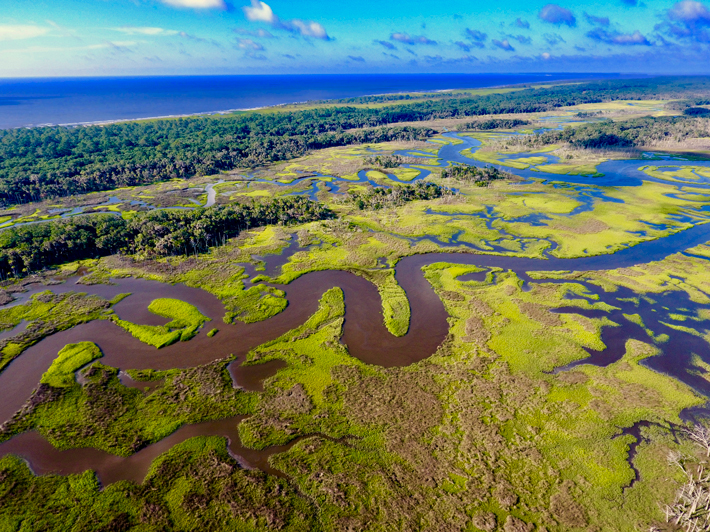 Draped in Spanish moss and overrun by the wild descendants of hogs introduced in the sixteenth century, Georgia’s Ossabaw Island is both a time capsule and rural oasis. Just 20 miles south of Savannah by water, Ossabaw spans 26,000 acres. Among its hundreds of archaeological features, representing at least 4,000 years of human habitation, are shell rings and burial mounds left by the earliest inhabitants, remains of precontact Native American villages, and eighteenth-century indigo plantations. According to archaeologist Victor Thompson of the University of Georgia, Ossabaw may have been abandoned at some time before the Spanish arrived on the Georgia coast in the 1540s. Archaeologists hope to determine when and why the island’s indigenous people, the Guale, left. Ossabaw was in private hands until 1978, when its owner, the now 105-year-old Eleanor Torrey West, sold it to the state, with the stipulation that it be protected as a cultural and environmental preserve. Ossabaw is only accessible by boat, and visitation is limited. Fortunately for history buffs and nature lovers, the nonprofit Ossabaw Island Foundation offers tours and overnight stays and hosts public events throughout the year. The foundation has also restored several buildings belonging to the island’s North End Plantation, including three mid-nineteenth century tabby cabins that were originally houses for enslaved people. They are named for their unique construction style, which uses a type of concrete made of oyster shells, lime, and sand. The cabins, says foundation director Elizabeth DuBose, are important monuments to Ossabaw’s heritage. Well into the twentieth century, the buildings were occupied by descendants of slaves. Their West African cultural traditions, now known as Gullah Geechee, continue to thrive across the Georgia and South Carolina Lowcountry.
Draped in Spanish moss and overrun by the wild descendants of hogs introduced in the sixteenth century, Georgia’s Ossabaw Island is both a time capsule and rural oasis. Just 20 miles south of Savannah by water, Ossabaw spans 26,000 acres. Among its hundreds of archaeological features, representing at least 4,000 years of human habitation, are shell rings and burial mounds left by the earliest inhabitants, remains of precontact Native American villages, and eighteenth-century indigo plantations. According to archaeologist Victor Thompson of the University of Georgia, Ossabaw may have been abandoned at some time before the Spanish arrived on the Georgia coast in the 1540s. Archaeologists hope to determine when and why the island’s indigenous people, the Guale, left. Ossabaw was in private hands until 1978, when its owner, the now 105-year-old Eleanor Torrey West, sold it to the state, with the stipulation that it be protected as a cultural and environmental preserve. Ossabaw is only accessible by boat, and visitation is limited. Fortunately for history buffs and nature lovers, the nonprofit Ossabaw Island Foundation offers tours and overnight stays and hosts public events throughout the year. The foundation has also restored several buildings belonging to the island’s North End Plantation, including three mid-nineteenth century tabby cabins that were originally houses for enslaved people. They are named for their unique construction style, which uses a type of concrete made of oyster shells, lime, and sand. The cabins, says foundation director Elizabeth DuBose, are important monuments to Ossabaw’s heritage. Well into the twentieth century, the buildings were occupied by descendants of slaves. Their West African cultural traditions, now known as Gullah Geechee, continue to thrive across the Georgia and South Carolina Lowcountry.
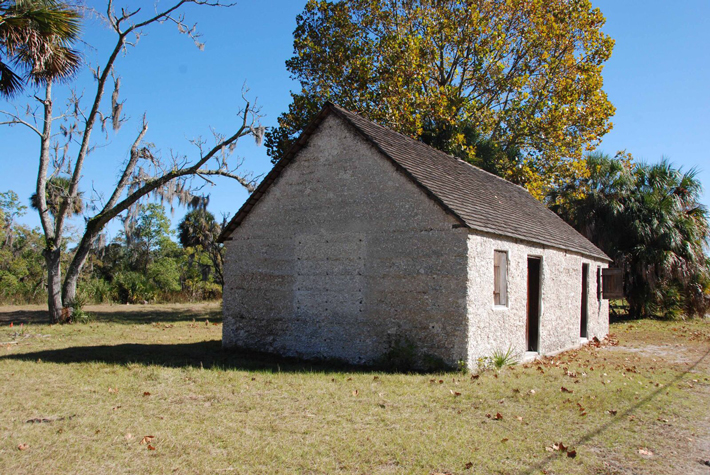 The Site
The Site
Arrange a day or overnight trip and take a safari along the oak-lined dirt road that bisects the island. Keep an eye out for whitetailed deer, armadillos, shorebirds, and alligators. While its interior is not open to the public, you can still catch a glimpse of the 1920s Spanish-style mansion where the Torrey family hosted Rockefellers and Carnegies during the Jazz Age. In addition to touring the restored tabby cabins and prehistoric sites nearby, visitors can also take part in a public participation day during the University of Georgia’s annual summer field school. You might find yourself searching for a new site using ground-penetrating radar or excavating a Late Archaic midden.
While You're There
You can’t go wrong strolling around nearby Savannah, which has one of the largest historic districts in the United States. The city is home to world-class museums and a vibrant culinary scene. Visit the 1819 Owens-Thomas House with its restored gardens and slave quarters, a monument both to Savannah’s antebellum elegance and the brutal system upon which it relied.
Advertisement
Advertisement
IN THIS ISSUE
From the Trenches
The Case of the Stolen Sumerian Antiquities
Off the Grid
Ancient Amazonian Chocolatiers
Fit for a Prince
When Things Got Cheesy
Funny Business
Double Vision
Raise a Toast to the Aurochs
A Lost Sock's Secrets
Land of the Ice and Snow
Bath Tiles
India's Anonymous Artists
No Rainbow Required
Passage to the Afterlife
World Roundup
Scottish clan memorabilia, a conquistador shrine, Neolithic nutmeg, Maya sea salt harvesters, and a Chinese model house
Artifact
Heirloom apparent
Advertisement

Recent Issues
-
 May/June 2024
May/June 2024
-
 March/April 2024
March/April 2024
-
 January/February 2024
January/February 2024
-
 November/December 2023
November/December 2023
-
 September/October 2023
September/October 2023
-
 July/August 2023
July/August 2023
-
 May/June 2023
May/June 2023
-
 March/April 2023
March/April 2023
-
 January/February 2023
January/February 2023
-
 November/December 2022
November/December 2022
-
 September/October 2022
September/October 2022
-
 July/August 2022
July/August 2022
-
 May/June 2022
May/June 2022
-
 March/April 2022
March/April 2022
-
 January/February 2022
January/February 2022
-
 November/December 2021
November/December 2021
-
 September/October 2021
September/October 2021
-
 July/August 2021
July/August 2021
-
 May/June 2021
May/June 2021
-
 March/April 2021
March/April 2021
-
 January/February 2021
January/February 2021
-
 November/December 2020
November/December 2020
-
 September/October 2020
September/October 2020
-
 July/August 2020
July/August 2020
-
 May/June 2020
May/June 2020
-
 March/April 2020
March/April 2020
-
 January/February 2020
January/February 2020
-
 November/December 2019
November/December 2019
-
 September/October 2019
September/October 2019
-
 July/August 2019
July/August 2019
-
 May/June 2019
May/June 2019
-
 March/April 2019
March/April 2019
-
 January/February 2019
January/February 2019
-
 November/December 2018
November/December 2018
-
 September/October 2018
September/October 2018
-
 July/August 2018
July/August 2018
-
 May/June 2018
May/June 2018
-
 March/April 2018
March/April 2018
-
 January/February 2018
January/February 2018
-
 November/December 2017
November/December 2017
-
 September/October 2017
September/October 2017
-
 July/August 2017
July/August 2017
-
 May/June 2017
May/June 2017
-
 March/April 2017
March/April 2017
-
 January/February 2017
January/February 2017
-
 November/December 2016
November/December 2016
-
 September/October 2016
September/October 2016
-
 July/August 2016
July/August 2016
-
 May/June 2016
May/June 2016
-
 March/April 2016
March/April 2016
-
 January/February 2016
January/February 2016
-
 November/December 2015
November/December 2015
-
 September/October 2015
September/October 2015
-
 July/August 2015
July/August 2015
-
 May/June 2015
May/June 2015
-
 March/April 2015
March/April 2015
-
 January/February 2015
January/February 2015
-
 November/December 2014
November/December 2014
-
 September/October 2014
September/October 2014
-
 July/August 2014
July/August 2014
-
 May/June 2014
May/June 2014
-
 March/April 2014
March/April 2014
-
 January/February 2014
January/February 2014
-
 November/December 2013
November/December 2013
-
 September/October 2013
September/October 2013
-
 July/August 2013
July/August 2013
-
 May/June 2013
May/June 2013
-
 March/April 2013
March/April 2013
-
 January/February 2013
January/February 2013
-
 November/December 2012
November/December 2012
-
 September/October 2012
September/October 2012
-
 July/August 2012
July/August 2012
-
 May/June 2012
May/June 2012
-
 March/April 2012
March/April 2012
-
 January/February 2012
January/February 2012
-
 November/December 2011
November/December 2011
-
 September/October 2011
September/October 2011
-
 July/August 2011
July/August 2011
-
 May/June 2011
May/June 2011
-
 March/April 2011
March/April 2011
-
 January/February 2011
January/February 2011
Advertisement






